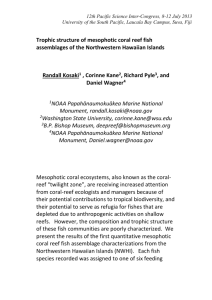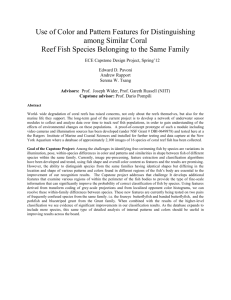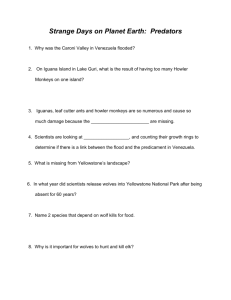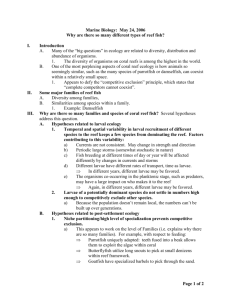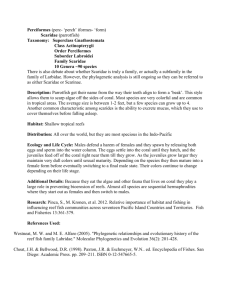Final Report - Rufford Foundation
advertisement
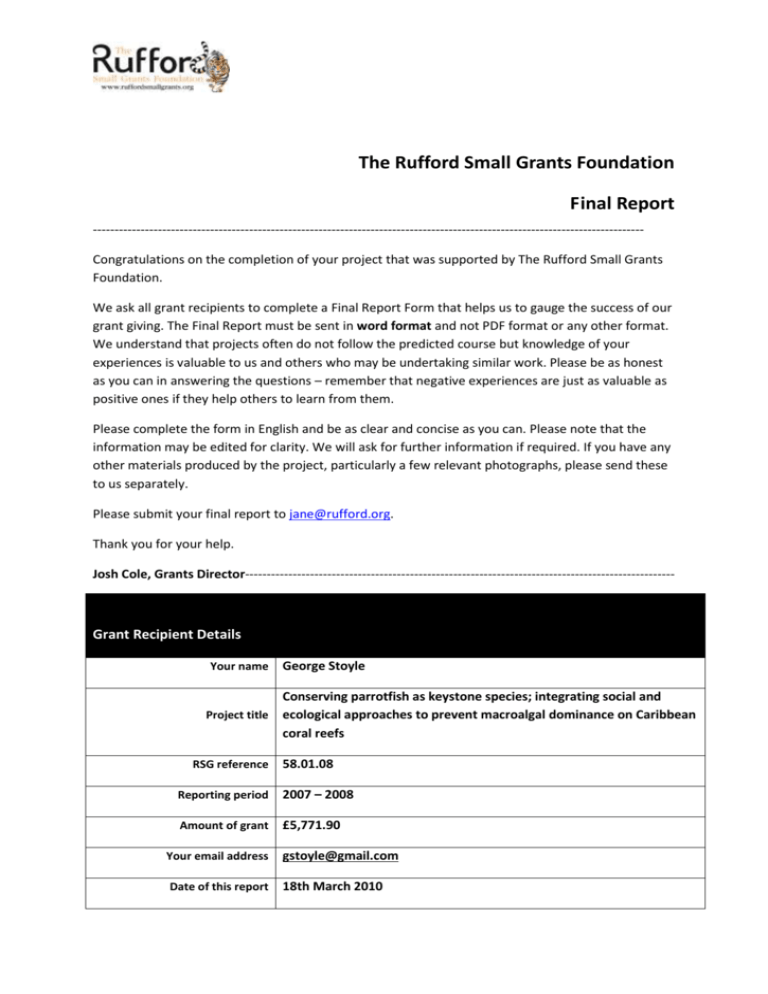
The Rufford Small Grants Foundation Final Report ------------------------------------------------------------------------------------------------------------------------------Congratulations on the completion of your project that was supported by The Rufford Small Grants Foundation. We ask all grant recipients to complete a Final Report Form that helps us to gauge the success of our grant giving. The Final Report must be sent in word format and not PDF format or any other format. We understand that projects often do not follow the predicted course but knowledge of your experiences is valuable to us and others who may be undertaking similar work. Please be as honest as you can in answering the questions – remember that negative experiences are just as valuable as positive ones if they help others to learn from them. Please complete the form in English and be as clear and concise as you can. Please note that the information may be edited for clarity. We will ask for further information if required. If you have any other materials produced by the project, particularly a few relevant photographs, please send these to us separately. Please submit your final report to jane@rufford.org. Thank you for your help. Josh Cole, Grants Director--------------------------------------------------------------------------------------------------- Grant Recipient Details Your name George Stoyle Conserving parrotfish as keystone species; integrating social and Project title ecological approaches to prevent macroalgal dominance on Caribbean coral reefs RSG reference 58.01.08 Reporting period 2007 – 2008 Amount of grant £5,771.90 Your email address gstoyle@gmail.com Date of this report 18th March 2010 1. Please indicate the level of achievement of the project’s original objectives and include any relevant comments on factors affecting this. Objective Not achieved Partially achieved Demonstrate the functional role of herbivores on Caribbean coral reefs Quantify the current causes and levels of herbivore removal Demonstrate the importance of functional species to island’s economy Demonstrate the role of patch size in the feeding intensity of herbivorous reef fish and recolonisation or retreat of macroalgae Produce simulation model of algal dynamics and growth as mediated by parrotfish Produce scientific publication and disseminate results to local community and relevant groups Fully achieved Comments Following manipulation macroalgal growth was not prevented as studies suggest, showing functional role of herbivores in this area has been lost. Prior to the study the decline in herbivores was thought to be the result of overfishing. Observer data shows this not to be the case. However, it is currently unknown why these species are in decline (this is a focus for further study). It is thought approx. 85% of the island’s economy depends on tourism, most of which depends on the health of the coral reefs. Although not shown explicitly in the data the project outcomes demonstrate a connection between declines in herbivores and declines in reef health. Data shows herbivores are increasingly attracted to graze in larger free patches, and in addition to the overall biomass, the patch-size dependent responses in grazing behaviour may be a key factor affecting algal succession on coral reefs. Data collected enabled development of a binary logistic regression model to predict the response of feeding intensity to the size of a cleared patch of macroalgae. A scientific report has been written and will be submitted to international scientific publications. Data was presented at presentations and conferences both locally and internationally. Materials have been produced and are available through the UCME website and the office on Utila. 2. Please explain any unforeseen difficulties that arose during the project and how these were tackled (if relevant). Although not necessarily unforeseen, a number of minor difficulties were encountered during the initial stages of the project. Due to the relatively remote project location combined with a limited budget and the fact Honduras is a developing country, certain equipment was not possible to obtain. In the absence of such equipment improvised techniques were employed to achieve best results. The study plots required relatively large fixed quadrats to be held in place at 15m depth for 6-12 months. During the wet season, when the trade winds blow from the East, the study plots were subjected to fairly rough conditions. The method of securing the quadrats was ineffective against large swells requiring routine maintenance which, at times, detracted from the survey. Ideally the minimum number of researchers present during observation periods would have been 2 per plot. This would have improved the quality of the data by including number of bites for specific fish. With one observer per plot it was only possible to record binary data, i.e. if the fish bit or did not bite. 3. Briefly describe the three most important outcomes of your project. 1. Studies suggest sufficient levels of herbivory should prevent macroalgal dominance allowing coral recruitment and thus strengthening ecosystem stability. Experimental macroalgal reduction initially resulted in significant increases in the density and feeding intensity of herbivorous coral reef fish. However, it quickly became apparent current levels of herbivorous reef fish were insufficient to maintain a low macroalgal assemblage. Three months post-treatment, macroalgae had successfully re-colonised all cleared patches (albeit at different rates) and herbivory had declined back to pre-treatment levels. This is an important finding as it demonstrates the requirement for management of herbivorous fish stocks in order to assist in the preservation of ecosystem stability. 2. Whilst existing levels of herbivory (mean density 1000 g 100 m-2) were not sufficient to maintain a low macroalgal assemblage in this area, the data collected enabled development of a binary logistic regression model to predict the response of feeding intensity to the size of a cleared patch of macroalgae. The model indicated that herbivores are increasingly attracted to graze in larger free patches, and in addition to the overall biomass, the patchsize dependent responses in grazing behaviour may be a key factor affecting algal succession on coral reefs. 3. The decline in herbivorous reef fish species was initially thought to be connected to artisanal and subsistence fisheries. To record catch levels an impartial observer was placed at a fish processing plant to monitor size and species landed by local fishermen. Contrary to what was assumed, herbivorous species, such as parrotfish and surgeonfish, only constituted a tiny percentage of total catches, with species such as grouper and snapper far more common. Although socioeconomic data revealed parrotfish were historically caught in large numbers, current levels of fishing for these species appears low enough to have enabled stock recovery. However, this is not the case. These findings therefore warrant further study into the causes for declines in herbivorous species. 4. Briefly describe the involvement of local communities and how they have benefitted from the project (if relevant). Through previously established links with Zamorano Pan-American School for Agriculture, students were trained to assist in ecological monitoring and data collection. This provided them with crucial experience in the sustainable management of natural resources and aiding projects associated with restoration of threatened species and habitats critical to the livelihoods of communities within Honduras and Latin America. Support for the project from key stakeholders within the fishing community was maintained through a close working relationship between the owners of the fish processing facility and UCME. This will continue to build over time enabling the continuation of numerous conservation projects. Without this support the achievement of conservation objectives would not be possible. The same support and trust has been maintained with the local Municipal authorities including the Mayor, and the owners and managers of the dive industry on Utila. During the project a number of public and private meetings were held in order to not only present on-going results but to also continue providing education regarding the value of coral reefs to the community, the processes driving reef health and the negative impacts of resource misuse. In particular information was, and still is, regularly disseminated to the owners of the fish processing facility, who supported the project and understand the importance of what UCME are trying to achieve as a whole. These are key stakeholders and have a great deal of influence over how the island’s fisheries are run, so it is crucial to maintain this working relationship and continue to provide reliable information regarding the status of the island’s fish stocks and health of its coral reefs. An important outcome of the project was building community awareness regarding the role of species such as parrotfish by demonstrating how the dynamics of the entire reef ecosystem are affected as a result of their decline. It is only through local support and understanding that measures for effective conservation can be put in place whereby communities manage their own resources in a sustainable manner. 5. Are there any plans to continue this work? Funding permitted, this project could be expanded in a 3 crucial ways: 1. Further investigation into the causes of the decline of herbivorous species, specifically looking at the impact of fish trapping; 2. Repeat patch dynamic study at different depths and areas of greater/lower coral/macroalgal cover; 3. 3-months post-treatment, macroalgal density had returned to pre-treatment levels. However, the dominant post-treatment species differed from that of the pre-treatment. This warrants further investigation as information regarding the patch-dynamics of tropical macroalgae are limited. 6. How do you plan to share the results of your work with others? Ecological data has been used to produce a scientific report which will be submitted to relevant international journals. Further reports and data will be made available through the UCME website with paper copies available in the office on Utila. Data has also been presented to the local community and to the scientific community, both locally and internationally. 7. Timescale: Over what period was the RSG used? How does this compare to the anticipated or actual length of the project? The RSG was used over a period of 12 months, from April 2007 to April 2008. 8. Budget: Please provide a breakdown of budgeted versus actual expenditure and the reasons for any differences. All figures should be in £ sterling, indicating the local exchange rate used. Item Materials necessary for establishing 2 x 6m2 permanent quadrats and conducting observations Materials necessary to monitor growth rate of algae postmanipulation Materials necessary for monitoring parrotfish size and catch Subsistence for 4 interns Office equipment and support per month Training materials Budgeted Amount £383.90 Actual Amount £383.90 Difference Comments £870 £1324.66 £454.66 Additional equipment for successful operation was required following original order. £204 £204 £2490 £2490 £240 £240 £584 £584 Production of £1000 educational materials Total £5771.90 £1000 £6226.56 9. Looking ahead, what do you feel are the important next steps? It is crucial to maintain links with key members of the community in order that future conservation projects be made possible. Regarding this project it is clear further investigation is required in order to provide important conclusions regarding the relationship between current levels of herbivorous fish stocks and the rate of coral reef decline in the area. Although fishing for these species does not seem to present an immediate problem, if stocks were to recover the results of this project demonstrate their importance to ecosystem integrity by showing the results of their decline. Therefore education regarding the conservation of keystone species should continue to be provided to all resource users and managers, not only throughout the region but the wider Caribbean. Although this project goes in some way to show the decline in herbivorous fish species is not a direct result of fisheries, it does not provide any other explanations for this decline - there are still many unanswered questions. Further anecdotal data suggests the average body size of species such as parrotfish is also in decline which implies there is a disruption at some point in their life-cycle. This could be for any number of reasons including mangrove pollution and habitat loss, as well as the use of juvenile species in fish traps to attract larger predatory species such as grouper (which are also in sharp decline). However, these factors are currently unknown. There is clearly scope here for further study. Ascertaining the cause/s of declines in the abundance and biomass of these keystone species is one of the critical steps required to enable regeneration of a severely degraded ecosystem. 10. Did you use the RSGF logo in any materials produced in relation to this project? Did the RSGF receive any publicity during the course of your work? The logo (with link to The Rufford Foundation website) is used on the UCME website with a description of the project and its intended outcomes. A presentation was also given at the 2008 RCUK conference at the Zoological Society of London. The Rufford logo was used in the acknowledgements. A number of other presentations have been made locally and at all times it was made clear the project was made possible by The Rufford Foundation. 11. Any other comments? UCME would like to thank The Rufford Foundation for the provision of funds that made this project possible. We would also be very grateful for the opportunity to apply for a follow-up grant in order to pursue this project further and continue providing a valuable contribution to coral reef research and community education in the region.
